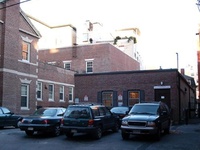But the lack of classroom space is almost equally drastic and perhaps more painfully apparent to professors like Canning. SPH has only one classroom—the 180-seat “classroom number one”—that can hold more than 75 students, and only three more at that size, according to Riccardi.
“That’s a real hardship and a real handicap,” he says.
And the dearth of office space puts a crimp in any plans to expand or recruit new faculty.
“Every time there’s a search for a new professor, part of that is, where are you going to put them,” says Senior Lecturer Stephanie A. Shore. “I don’t think we can grow any more than what we are.”
A “master plan” compiled by Payette found SPH will need nearly 200,000 square feet to grow over the next ten years, on top of the 100,000 square feet needed to alleviate current overcrowding. And the school would like to add another 150,000 square feet for student space that it currently lacks, like dining areas, athletic facilities and study lounges.
That sums to a total footprint of about 1.2 million square feet, a figure that jumps to 1.4 million after twenty years.
Compounding the school’s space crunch is the antiquated infrastructure of the school’s current facilities—three of the four main buildings date from the 1960s or 1970s and require upgrades to their mechanical, electrical and plumbing systems. SPH thus finds itself in a position where to keep its current Longwood buildings, it must renovate anyway, so the time is ripe for consideration of a new campus, the report says.
The master plan considers variations on three main options to deal with the space and infrastructure issues confronting SPH: remaining at its current site with major renovations, moving to Allston, or purchasing entirely new land for an ample campus more proximate to Longwood than Allston. The report recommends two specific plans.
One is for SPH to remain in Longwood but to totally overhaul its current facilities, including replacing its second-largest structure, the 149,000 square foot Kresge building, with an entirely new facility. It also accounts for the planned construction of a joint Harvard Medical School (HMS)-SPH building adjacent to SPH’s current buildings, which would add approximately 80,000 square feet to SPH’s Longwood holdings.
This plan, at a cost of about $410 million over 20 years, would leave SPH with about 950,000 square feet in Longwood and a remaining 450,000 square feet in outlying space.
The other recommended alternative is for SPH to build a campus from scratch in Allston, while retaining its brand-new 105,000 square foot Francois-Xavier Bagnoud building on Huntington Ave. as a link between the school’s new Allston campus and its Longwood roots.
For about $560 million over 20 years, this plan would provide SPH with state-of-the-art facilities and space for its entire operation on one unified campus.
But while a brand-new campus boasting ample room may be alluring, not all professors are gung-ho about an Allston move.
“Just more space, to my way of thinking, is not an appropriate tradeoff,” says Professor of Biostatistics Nan M. Laird.
2003: An Allston Odyssey
Read more in News
Black Female Alums Celebrate Third Decade














